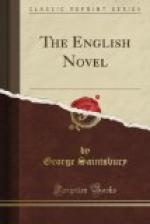of Dickens in a partial following of the manner of
Thackeray. An “abuse”—the
distribution in supposed unjust proportion of the funds
of an endowed hospital for aged men—is its
main avowed subject. But Trollope indulged in
no tirades and no fantastic-grotesque caricature—in
fact he actually drew a humorous sketch of a novel
a la Dickens on the matter. His real object
was evidently to sketch faithfully, but again not
without humour, the cathedral society of “Barchester”
as it actually spoke, dressed, thought, and lived:
and he did it. The first book had a little too
much talk about the nominal subject, and not enough
actual action and conversation. Barchester Towers
remedied this, and presented its readers with one of
the liveliest books in English fiction. There
had been nothing like it (for Thackeray had been more
discursive and less given to small talk) since Miss
Austen herself, though the spirits of the two were
extremely different. Perhaps Trollope never did
a better book than this, for variety and vigour of
character drawing. The masterful wife of Bishop
Proudie, the ne’er-do-weel canon’s family
(the Stanhopes), and others stand out against an interest,
not intense but sufficient, of story, a great variety
of incident, and above all abundant and lifelike conversation.
For many years, and in an extraordinary number of
examples, he fell little below, and perhaps once or
twice went above, this standard. It was rather
a fancy of his (one again, perhaps, suggested by Thackeray)
to run his books into series or cycles—the
chief being that actually opened as above, and continuing
through others to the brilliant Last Chronicle
of Barset (1867), which in some respect surpasses
Barchester Towers itself, with a second series,
not quite disconnected, dealing with Lady Glencora
Palliser as centre, and yet others. His total
production was enormous: it became in fact impossibly
so, and the work of his last lustrum and a little
more (say 1877-1882), though never exactly bad or
painful to read, was obvious hack-work. But between
The Warden and The American Senator,
twenty-two years later, he had written nearer thirty
than twenty novels, of which at least half were much
above the average and some quite capital.[26] Moreover,
it is a noteworthy thing, and contrary to some critical
explanations, that, as his works drop out of copyright
and are reprinted in cheap editions, they appear to
be recovering very considerable popularity. This
fact would seem to show that the manners, speech,
etc., represented in them have a certain standard
quality which does not—like the manner,
speech, etc., of novels such as those of Hook
and Surtees—lose appeal to fresh generations;
and that the artist who dealt with them must have
had not a little faculty of fixing them in the presentation.
In fact it is probably not too much to say that of
the average novel of the third quarter of the
century—in a more than average but not
of an extraordinary, transcendental, or quintessential
condition—Anthony Trollope is about as good
a representative as can be found. His talent
is individual enough, but not too individual:
system and writer may each have the credit due to
them allotted without difficulty.




